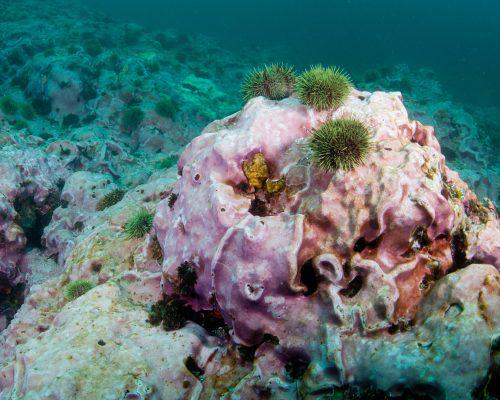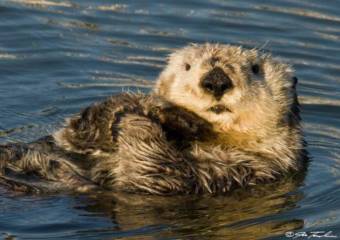
Sea urchins are devouring the massive limestone reefs surrounding the central and western Aleutian Islands — a process exacerbated by climate-driven changes in the marine environment, according to a new study published in Science.
In Unalaska, the largest community in the 1,200-mile Aleutian archipelago, rich kelp beds and curious otters line the island’s shores.
“We’re pretty lucky here — especially in Unalaska Bay — we have a very healthy and, what appears to be, growing sea otter population which is able to keep the sea urchins in check,” said Melissa Good, the local marine advisory agent with Alaska Sea Grant.
According to Good, there are two healthy sea otter populations in the Aleutian Islands — in Unalaska Bay and in Clam Lagoon in Adak. She said the reason the population is healthy in Unalaska is that the otters are protected from orcas due to the infrastructure from the multi-billion dollar fishing industry.
“We see the sea otters swimming around and hanging out, sleeping in the kelp reefs right here in Unalaska Bay, especially in the inner harbor areas which means that orcas are not likely to come in and predate on them,” Good said. “They have protection.”
But in other parts of the central and western Aleutians — starting west of Samalga Pass and the Islands of Four Mountains — a sharp decline in the otter population from killer whale predation starting in the 1990s has led to a boom in sea urchins, according to Brenda Konar, a professor of marine biology at the University of Alaska Fairbanks.

Konar says the theory is that killer whales used to eat many of the “great whales,” 13 extremely large Cetacean species. But as many of the great whale species were hunted down, killer whales were forced to switch their prey. So they switched from eating whales to eating Steller sea lions, fur seals and harbor seals, and continued down the marine mammal food chain until they eventually got to sea otters.
In the central and western Aleutians, the otter populations plummeted.
Now uncontrolled by sea otters, their natural predator — the urchin population — boomed both in body size and density.
“The sea urchins can be ridiculously dense,” Konar said. “In a 3-foot by 3-foot section, you can find 400 of these urchins just sitting there, trying to eat away at the kelp.”
Those sea urchins, which are “tremendous grazers” according to Konar, began eating more kelp that grows on the reefs, decimating the vast kelp forests that went on for miles in the Aleutian archipelago.
“And so now you’ve lost the habitat that organisms were normally coming into and living there, reproducing there and eating there,” said Good. “You can think of seaweed-like plants on land as the base of the food web. And so when you have a lot of seaweed out there, you also have a lot of food. And so when you completely get rid of that you’ve eliminated the space for other animals. You have basically clear cut the forest of the sea.”
Having decimated the kelp, urchins are now eating Clathromorphum nereostratum, the algae that create the reefs.
“So first, the kelp forests disappeared,” said Konar. “Now, the reef underneath the kelp forest is disappearing.”
Konar began diving in the Aleutians in the 1990s, just as the Aleutian sea otter population began to crash. She is also a co-author of the new study in Science about what’s happening to Aleutian reefs.
“And what’s happening is, it’s not just that there’s a lot of sea urchins out there eating and digging away at these coralline biogenic habitats, but it’s also that the warming temperature and ocean acidification is weakening these coralline plants and making it even easier for the sea urchins to erode them away,” Konar said.
The research shows that sea urchin grazing has become much more lethal in recent years due to the emergent effects of climate change, according to Doug Rasher, a senior research scientist at Bigelow Laboratory for Ocean Sciences in Maine and lead author of the study.
Large urchins are chomping away at a faster rate than the algae can grow.
“Ocean warming and acidification are making it difficult for calcifying organisms to produce their shells — in this case, the algae’s protective skeleton. This critical species has now become highly vulnerable to urchin grazing, right as urchin abundance is peaking. It’s a devastating combination,” Rasher said.
In some places, reefs that are meters thick and thousands of years old are crumbling from urchins burrowing through the weakened calcium carbonate structures.
“These coral reefs live hundreds and hundreds and hundreds of years,” Konar said. “And so if they’re being eroded as much as they are in just a couple of years, and it takes them a few hundred years to regrow that amount, even if everything stopped today and the otters came back, the urchins got eaten up and everything became rosy again, it would take these coralline crusts a really long time to come back.”
Despite Konar’s uncertainty, Rasher said their study indicates that restoring sea otters to the central and western Aleutians would result in a decline in sea urchins and the recovery of kelp forests.
